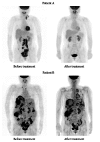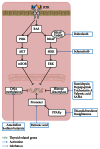Personalized Medicine Based on Theranostic Radioiodine Molecular Imaging for Differentiated Thyroid Cancer
- PMID: 27239470
- PMCID: PMC4864569
- DOI: 10.1155/2016/1680464
Personalized Medicine Based on Theranostic Radioiodine Molecular Imaging for Differentiated Thyroid Cancer
Abstract
Molecular imaging based personalized therapy has been a fascinating concept for individualized therapeutic strategy, which is able to attain the highest efficacy and reduce adverse effects in certain patients. Theranostics, which integrates diagnostic testing to detect molecular targets for particular therapeutic modalities, is one of the key technologies that contribute to the success of personalized medicine. Although the term "theranostics" was used after the second millennium, its basic principle was applied more than 70 years ago in the field of thyroidology with radioiodine molecular imaging. Differentiated thyroid cancer, which arises from follicular cells in the thyroid, is the most common endocrine malignancy, and theranostic radioiodine has been successfully applied to diagnose and treat differentiated thyroid cancer, the applications of which were included in the guidelines published by various thyroid or nuclear medicine societies. Through better pathophysiologic understanding of thyroid cancer and advancements in nuclear technologies, theranostic radioiodine contributes more to modern tailored personalized management by providing high therapeutic effect and by avoiding significant adverse effects in differentiated thyroid cancer. This review details the inception of theranostic radioiodine and recent radioiodine applications for differentiated thyroid cancer management as a prototype of personalized medicine based on molecular imaging.
Figures






References
-
- Gilham I. Theranostics an Emerging Tool in Drug Discovery and Commercialisation. 2002. http://www.ddw-online.com/personalised-medicine/p148484-theranostics-an-....
-
- Moghimi S. M., Farhangrazi Z. S. Encyclopedia of Cancer. Berlin, Germany: Springer; 2015. Theranostics; pp. 1–3. - DOI
Publication types
MeSH terms
Substances
Grants and funding
LinkOut - more resources
Full Text Sources
Other Literature Sources
Medical

